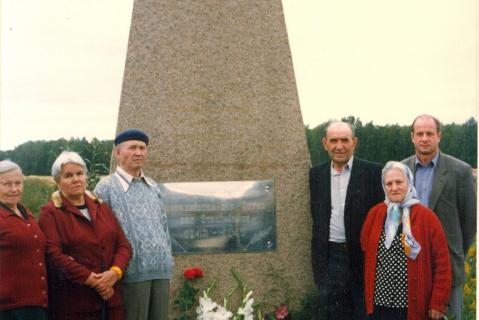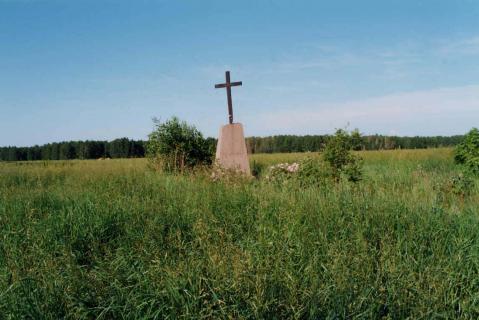In 1942-1948 sub-divisions of Bakallag were based in the Metallurgical district of Chelyabinsk. The prisoners built and serviced the Metallurgical Combine. More than half of their number were Soviet German forced labourers. In 1942-1944 the prisoners and forced labourers who died were buried in the camp cemetery seven kilometres from Pershino settlement. They were buried in trenches without any distinguishing markers. The numbers then buried have not been established: researchers estimate there were between 20,000 and 30,000. In mid-1943 part of the cemetery became the slag-disposal area of the combine and was flooded with liquefied metal waste.
In the 1970s the rest of the cemetery was used by the Metallurgical Combine for its farm and garden plots. In late 1989 the Centre for German Culture and the Catholic community of Chelyabinsk proposed that the 8 hectares of the cemetery plot be taken out of cultivation: a fence was erected, poplar trees were placed along the fence and a central avenue was created. In 1993 a granite pillar was erected. It is engraved with words from Akhmatova’s Requiem: “I would like to remember them all by name” and a metal plaque below carried the text:
“Hier ruhen in Gott Trudarmisten – die Opfer des Stalinismus, 1942-1945” (Here in the peace of God lie forced labourers, the victims of Stalinism).
Subsequently the metal parts of the monument were stolen. The cross was lost and the metal plaque, found at the processing centre for non-ferrous metals, was given to the Church of the Immaculate Conception of the Holy Virgin Mary [74-02]. In 2004 remains were exhumed from one of the common graves to create a symbolic grave as part of the memorial complex in the grounds of the church.
The electronic Book of Remembrance of Soviet Germans (Gedenkbuch) contains biographical entries on more than 100,000 Soviet Germans variously sentenced under Article 58, deported as forced settlers, or mobilised in camps of forced labourers.
The Memorial online database (2025) includes 32,342 victims in the Chelyabinsk Region (BR 22,836).
Over a half were local residents (18,625). Almost 12,000 were held in the camps; over 800 were deported from the Region. Police records add and name 9,429 German women and men transferred from elsewhere to special settlements in the Chelyabinsk Region.
The database also lists 20,000 deported with their families in the early 1930s from Tatarstan to the Chelyabinsk Region (and 5,184 who were born there).
| Date | Nature of ceremonies | Organiser or responsible person | Participants | Frequency |
|---|---|---|---|---|
|
28 Aug.
|
Day of Remembrance and Sorrow of Russian Germans
|
German cultural centre
|
City officials, relatives of the victims, NGOs, clergy
|
Annual event, 1994-2003; from time to time thereafter
|
| State of burials | Area | Boundaries |
|---|---|---|
|
have survived in part
|
memorial cemetery covers 8 hectares
|
not delineated
|
[ original texts and hyperlinks ]
G.A. Volter, A zone of complete peace. Russian Germans during the war years and after – eyewitness testimony, ed. V.F. Dizendorf, Moscow, 1998, 2nd edn. (416 pp)
L. Sadchikova, “ … a memorial to forced labourers is near completion in the Metallurgical district”, Chelyabinsk rabochy, 17 August 2004
L. Sadchikova, “… a memorial to forced labourers will open at the Catholic church of the Immaculate Conception”, Chelyabinsk rabochy, 21 September 2004
V. Zagvozdin, “Jesus as remembrance: today a memorial to forced labourers will be unveiled”, Uralskye obshchestvennye vedomosti (Chelyabinsk), 18 Sept. 2004
A. Kuznetsova, “Bakallag on the modern map of the city’s Metallurgical district: a school research project”, School No 74, Chelyabinsk, 2010
N. Paegle, V. Osipov, On the other bank: Russian Germans, from the past into the future, Yekaterinburg, 2012
Gedenkbuch: A book of remembrance of the German forced labourers at Bakallag, 1942-1946, Vol. 4, Nizhny Tagil, 2014 (1,034 pp)


